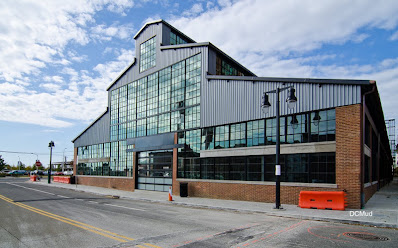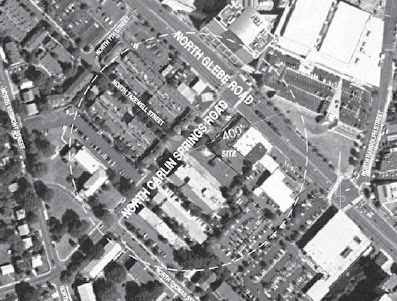10 Questions is a new weekly feature in which we interview some of the leading District figures in real estate, architecture, development, and planning. This week's subject ... Harriet Tregoning, Director of the Washington DC Office of Planning.
One of the country's leading advocates of "smart growth," Tregoning has spearheaded the District's shift from an undirected, auto-centric hodgepodge to a bikeable, pedestrian-friendly 21st century community. If you've used a bike lane, walked home with groceries, or commuted to or from work in less than thirty minutes, you probably owe her some thanks.
1. What's a typical day for you?
Get up and get dressed; walk dogs; check text messages and answer overnight emails; bike to first meeting of the day, maybe somewhere downtown. Go on to the office and work with staff on a couple of on-going plans and projects. Head to the Wilson Building for a meeting with colleagues (from other agencies) or meet with Council staff. Grab a late lunch somewhere, maybe a food truck near L’Enfant Plaza on the way back to the office. Return calls, send emails, check Twitter, read. Then I might host one or two more meetings --with residents who have concerns about their neighborhood, a land owner who has a project they want to see if they could build in DC, or a non-profit about what we could do together to solve a particular DC problem, e.g., like producing and retaining affordable housing or helping make fresh and healthy food more available throughout the city.
After leaving the office for the day, I might attend a community meeting, give a talk, or hear a lecture- that’s how I spend a typical evening. If I am free, I might meet my husband for dinner in our neighborhood or play a quick game of tennis under the lights at Banneker.
2. What or who is your biggest influence?

I just got back from a gathering I really love – once or twice a year I get together with the Planning Chiefs in the top 30 largest American cities, many of whom are doing amazing things to make their cities more livable, sustainable, economically competitive and diverse. Their work is really inspiring.
3. What neighborhood do you live in?
Columbia Heights
4. What is your biggest DC pet peeve?
I don’t know if this is my BIGGEST DC pet peeve, but the bike/ped/car culture wars have been well covered.
So, TREES, specifically street trees. They have a very hard and very important job in the city. They make the city more beautiful – our streets with mature trees and a canopy that arches over the street are some of the most magnificent places in the city. They provide all kinds of shelter from the elements – protection from rain or snow, shade when it’s too hot and sunny. Compared to pavement or asphalt, they literally help to cool the city. They help manage the peak surge of stormwater when there is heavy rainfall; they provide habitat; when mature, they create both a vertical element along the street that provides both a more distinct edge, and a sense of enclosure – to drivers, the street seems more narrow, and their speeds are lower. For pedestrians, they create a physical buffer from cars and traffic.
We have a goal for the city of 40% tree canopy (we are at about 35% today), but most of our residents and businesses don’t know that THEY are responsible for watering the trees in front of their property and especially helping to establish young trees when they first get planted. They need about 20-25 gallons of water per week. So we have a very high mortality rate for our urban trees and we need help from our residents and businesses to get all those benefits that come from mature trees in our city.
5. What is the #1 most played song on your iPod?
With Arms Outstretched, Rilo Kiley
6. Favorite DC haunt?
Room 11 Patio and Banneker Tennis Courts – I probably spend the most time there after work and home.
7. What's your favorite thing to do on a Sunday afternoon?

Long dog walk, and then hang out at Meridian Hill Park
8. If you could live anywhere in the world, where would it be?
Here!
9. If you couldn't be an urban planner/smart growth advocate, what would you be?
A book editor or publisher.
10. Name one thing most people don't know about you.
I play the cello - very, very badly.
 With exterior construction of the boilermaker retail building complete, southeast DC will soon have its own retail pavilion in one of the city's more exciting venues. Forest City started construction on the project in late 2011, turning the century old boilermaker building of the Navy Yard into a waterfront retail locale for destination restaurants. With exterior work complete, tenants are now beginning to build out their restaurants, which should put opening day next spring. On track so far are Buzz Bakery and Blue Jacket brew pub, both operated by Neighborhood Restaurant Group. Blue Jacket, named after the common apparel for navy personnel, will take the end space (on 4th) with walls of glass reaching 3 stories to the steel raftered ceiling. On tap at the opposite end (on 3rd) is Willie's Brew & Crew (a sports bar & barbecue) from restaurant mogul Xavier Cervera, as well as a drycleaner. BRB, which had originally signed on, is no longer on the list, but officials say a burger joint is likely. Across the street construction is underway on a new apartment building, Harris Teeter, and now a Vida Fitness.
With exterior construction of the boilermaker retail building complete, southeast DC will soon have its own retail pavilion in one of the city's more exciting venues. Forest City started construction on the project in late 2011, turning the century old boilermaker building of the Navy Yard into a waterfront retail locale for destination restaurants. With exterior work complete, tenants are now beginning to build out their restaurants, which should put opening day next spring. On track so far are Buzz Bakery and Blue Jacket brew pub, both operated by Neighborhood Restaurant Group. Blue Jacket, named after the common apparel for navy personnel, will take the end space (on 4th) with walls of glass reaching 3 stories to the steel raftered ceiling. On tap at the opposite end (on 3rd) is Willie's Brew & Crew (a sports bar & barbecue) from restaurant mogul Xavier Cervera, as well as a drycleaner. BRB, which had originally signed on, is no longer on the list, but officials say a burger joint is likely. Across the street construction is underway on a new apartment building, Harris Teeter, and now a Vida Fitness.




















































